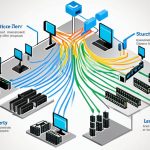The Optical Transport Network (OTN) is a key protocol in the telecom world. It helps move, switch, and combine different services over high-speed optical networks. OTN is like a “digital wrapper” that keeps each service’s original structure, timing, and management info safe during transport. This makes it a vital part of today’s connectivity1.
It brings many benefits. These include better reliability, easier operations, and stronger Service-Level Agreements (SLA). It also extends reach with Forward Error Correction (FEC) and uses wavelengths more efficiently. This makes OTN crucial for modern networks1.
Key Takeaways:
- OTN is a telecommunications industry standard protocol that efficiently transports, switches, and multiplexes services over high-capacity wavelengths.
- OTN acts as a “digital wrapper,” preserving the native structure, timing, and management information of each client/service.
- OTN provides benefits like increased resiliency, simplified operations, enhanced SLAs, extended reach with FEC, and efficient wavelength utilization.
- Operators can deliver differentiated services, maximize network efficiencies, and rapidly respond to service requirements with OTN infrastructure.
- OTN’s future-proof nature allows for the support of new line rates, technologies, and client interfaces without major infrastructure changes1.
What is OTN?
OTN stands for Optical Transport Network. It’s a key protocol in the telecommunications world. It helps move, switch, and combine different services on high-capacity wavelengths in optical networks. OTN makes sure different vendors and equipment work well together.
OTN wraps each service in a “digital wrapper”. This keeps the service’s original structure, timing, and management info safe. It makes transporting IP, Ethernet, storage, digital video, and SONET/SDH services efficient and reliable.
OTN is flexible and supports Ethernet from 1GE to 400GE. This meets a wide range of network needs2. It maps LAN, SONET/SDH, SAN, and other services over carrier WDM networks well. This reduces overhead and maps different traffic types efficiently3. OTN also offers cost-effective bandwidth options like 10G, 100G, 200G, and 400G, boosting optical network capacity34.
OTN improves network performance and reach. Its built-in Forward Error Correction (FEC) boosts signal quality, letting signals travel longer without needing regeneration sites3. This cuts down on system costs and boosts performance. Plus, OTN’s monitoring features make tracking the network easier and cheaper for various services3.
OTN saves money on network management and operations. Its OAM&P capabilities make managing the network more efficient. This leads to lower costs for service provisioning3.
High-capacity OTN devices are key to the network’s smooth operation. They help move critical traffic across different applications. OTN ensures reliable service delivery, making it a top choice for the telecom industry. Its strength and ability to grow make it ideal for resilient and high-performance networks.
OTN Information Structure
The OTN information structure is key for sending data quickly over optical networks. It has many parts that work together to keep data moving smoothly.
The OTM is at the heart of the OTN structure. It carries information across the optical interface with both a digital and optical design. This design makes it easy to send data in different amounts.
The OPU carries the actual data inside the OTM. The ODU includes the OPU and extra information like error-checking bytes. These bytes help manage the data as it travels.
The ODU makes sure data gets sent right and efficiently. It wraps the OPU frames with extra info for tracking and control.
The OTU is another important part of the OTN structure. It has the ODU overhead and payload, supports extra overhead, and helps with communication between nodes.
This structure makes sending data smooth and reliable. It breaks data into units for a strong and flexible way to communicate over optical networks.
OTN Technology in Optical Networking
Optical Transport Network (OTN) technology is key to building efficient and reliable optical networks. It’s perfect for handling lots of data and keeping connections smooth. Let’s dive into what makes OTN technology important in optical networking.
OTN Mapping and Agility
OTN technology is great at OTN mapping or encapsulation. This lets different types of traffic like IP, Ethernet, and video work together over OTN1. It makes OTN mapping very flexible for carrying various types of data.
Also, OTN mapping helps create fast and adaptable photonic connections. Coherent modems use this to send services over high-speed waves1. This boosts performance and makes the most of the network’s capacity.
OTN Muxponder for Cost-Effective Connectivity
OTN muxponders are vital for combining lower-speed signals into a single high-capacity OTN signal1. This makes connecting points efficiently and cost-effectively. It’s especially useful where using fiber capacity well is key.
OTN Centralized Fabric for Scalable Connectivity
Big networks in metro and core areas use OTN technology’s centralized fabric1. They multiplex signals onto a DWDM channel through a fabric. This setup offers flexible, scalable, and on-demand connections. It uses fiber capacity well and supports high-speed wavelengths.
Hybrid Packet and OTN Switching
There’s a new trend mixing packet and OTN switching in optical networking1. This mix lets networks be flexible and offer different services. It also helps quickly fix service issues.
Future-Proofing Networks with OTN
OTN technology is set to be a key solution for future networks. It supports current and future technologies1. With data rates going up, OTN’s ability to handle up to 400Gbps7 is vital for network growth.
Overall, OTN technology is crucial for optical networking. It offers better performance, simpler operations, and more connectivity options. Through OTN mapping, muxponders, fabric, or hybrid switching, it helps networks deliver reliable and efficient services in today’s digital world.
Key Operator Benefits of OTN
Operators gain a lot from using Optical Transport Network (OTN) in their networks. It offers many advantages and key benefits. These include better performance, easier operations, quicker service setup, and better network efficiency.
One big plus of OTN is its better performance. This comes from Forward Error Correction (FEC) in OTN networks. It makes the network more tolerant of problems and boosts system margin8. Also, real-time latency checks in OTN networks help keep latency within agreed limits8.
OTN also helps with end-to-end service monitoring. It uses built-in traffic monitoring and Tandem Connection Monitoring (TCM)8. This lets operators keep an eye on network performance and deliver high-quality services efficiently.
Moreover, OTN makes adding new services and capacity to Dense Wavelength Division Multiplexing (DWDM) networks easy. It separates the client from the DWDM line8. This makes setting up new services fast and helps operators meet customer needs quickly.
Another big advantage of OTN is how it lets different clients share the same optical network. This boosts network efficiency and uses bandwidth better8. By putting multiple services on one network, OTN cuts costs and makes operations smoother9.
Operators can also use OTN’s advanced programmability for quick service fixes. This is especially useful in networks that mix packet and OTN switching8.
In summary, OTN offers many benefits for operators. These include better performance, simpler operations, quicker service setup, and more efficient networks. With its high capacity, compatibility with various technologies, and error correction, OTN is a great choice for operators. It helps them save costs, meet customer needs, and support various applications9.
Understanding the benefits of OTN is crucial for network operators. They should think about the number of spans, distance, fiber type, link loss, data rate, and businesses to transmit when setting up an OTN network10. By considering these factors, operators can make sure their OTN networks work well and efficiently.
OTN Hierarchy Overview
In an Optical Transport Network (OTN), the hierarchy is key for managing and sending data well. It has levels like OTUk, ODUk, and OPUk. These work together to make sure data is sent reliably and in large amounts.
1. Optical Transport Unit (OTU)
The OTU is a main part of the OTN hierarchy. It adds overhead for sections and supports General Communication Channels (GCC) between nodes. The OTU makes sure data is sent safely and manages network resources well.
2. Optical Data Unit (ODU)
The ODU is important for data transport in the OTN. It has the OPU overhead and payload area, plus extra overhead like Tandem Connection Monitoring (TCM). It wraps client signals and sends them through the OTN without problems.
3. Optical Payload Unit (OPU)
The OPU holds the payload frames in the OTN hierarchy. It can carry services like IP, Ethernet, or others. The OPU is key for making the OTN flexible and able to send different services well.
By having a layered OTN, each layer has its own job and skills. This lets the network handle various data types and services well. It makes sending, switching, and combining services in the OTN smooth11.
| OTN Level | Data Rate | Associated Services |
|---|---|---|
| OTU2 | 10.70 Gbit/s | OC-192, WAN (10GBASE-W) |
| 12OTU2e | 11.09 Gbit/s | LAN (10.3 Gbit/s) |
| OTU3 | 43.01 Gbit/s | OC-768, 40 Gigabit Ethernet |
| OTU4 | 112 Gbit/s | 12100 Gigabit Ethernet |
There are specific data rates and services in the OTN for better network work. For example, OTU2 sends data at 10.70 Gbit/s and is used for OC-192 or 10 Gigabit Ethernet (10GBASE-W)12. OTU2e sends at 11.09 Gbit/s and helps transport LAN signals, like IP/Ethernet switches and routers, at 10.3 Gbit/s12.
Standards like ITU-T Recommendation G.709 guide the OTN hierarchy. They define how to map client signals, manage overhead bytes, and use Forward Error Correction (FEC) at the optical layer12. This makes sure different OTN setups work together well.
The OTN hierarchy makes networks use resources better, send data efficiently, and support many services. Its levels, like OTUk, ODUk, and OPUk, make it scalable and flexible for different needs and new technologies13. Using the OTN hierarchy lets operators use their optical networks fully and offer strong, high-capacity connections for many services.
OTN Overhead and Processing
The Optical Transport Network (OTN) uses overheads for reliable and efficient data transmission14. These overheads are key in managing and processing data in the network. They include the Optical Channel Data Unit (ODU), the Optical Transport Unit (OTU), and the Optical Payload Unit (OPU).
Optical Channel Data Unit (ODU)
The ODU has overheads for monitoring paths and finding faults14. These include Tandem Connection Monitoring (TCM), Backward Error Indication (BEI), and Trail Trace Identifier (TTI). TCM checks paths across different areas, ensuring smooth supervision and adaptation. BEI corrects errors, making transmission better. TTI gives a unique ID to each signal, making tracing easier.
Optical Transport Unit (OTU)
The OTU carries client signals in the OTN14. It uses overheads for smooth communication between nodes. Scrambling protects data from noise and interference. Frame Alignment Overhead (FAS and MFAS) keeps frames in order. General Communication Channels (GCC) help nodes talk to each other.
Optical Payload Unit (OPU)
The OPU’s overhead tells us about the signal type14. It supports many client signals and maps data into the payload. The Payload Structure Identifier (PSI) shows the payload’s structure, and the Payload Type (PT) tells us what kind of payload it is. Frequency Justification maps and aligns client signals for accurate OTN transmission.
These overheads and processes in the OTN are key for reliable data transmission14. They make the network more transparent, backward compatible, and less complex and costly14. By using OTN, network operators can offer top-quality services for LAN, MAN, and broadband access efficiently15.
| Optical Channel Data Unit (ODU) | Optical Transport Unit (OTU) | Optical Payload Unit (OPU) |
|---|---|---|
| Tandem Connection Monitoring (TCM) | Scrambling | Payload Structure Identifier (PSI) |
| Backward Error Indication (BEI) | Frame Alignment Overhead (FAS and MFAS) | Payload Type (PT) |
| Trail Trace Identifier (TTI) | General Communication Channels (GCC) | Frequency Justification |
Multiplexing in OTN
Optical Transport Network (OTN) makes it easy to multiplex data rates. This means it uses network resources well and can carry different types of traffic. ODUk multiplexing is key here, letting lower-speed signals ride on faster ODU containers. OTN’s ability to mix data rates helps in combining and sending various traffic streams.
ODUk multiplexing combines different data rates like ODU1, ODU2, and ODU3. Each type has its own way of fitting into the network. For example, four ODU1 signals can be packed into an ODU2, making it easier to send lower-speed signals over a faster line.
Also, ODU1/ODU2 signals can be put into an ODU3 container. This helps send sub-rated Ethernet and packet services over high-capacity wavelengths in the OTN. This method is key for efficient and reliable connections, especially with different traffic types.
Using ODUk multiplexing, network operators can make the most of their resources. They can also improve bandwidth use and meet the growing needs of various applications. Plus, combining lower-speed signals into faster containers helps grow network capacity affordably without big upgrades.
Multiplexing is vital in OTN. It helps bring together and efficiently send different data rates in one network. Whether it’s combining signals from various ODU containers or putting ODU1/ODU2 into a bigger ODU3, OTN’s multiplexing makes sure all traffic types flow smoothly.
| Multiplexing Technique | ODUk Configuration |
|---|---|
| 4x ODU1 to ODU2 | Four ODU1 signals aggregated into an ODU2 container |
| ODU1/ODU2 to ODU3 | Multiple ODU1 or ODU2 signals combined into an ODU3 container |
SDN Applied to Optical Networks
Software-Defined Networking (SDN) is key in making optical networks better and easier to manage. When SDN meets Optical Transport Network (OTN), it boosts network speed and handles traffic better18. SDN lets operators change traffic paths, use network resources wisely, and make sure important apps run smoothly18.
SDN and OTN work together to manage big traffic flows well18. SDN moves big data to special networks that can handle lots of data18. This keeps the network running well and stops other traffic from slowing down18.
SDN’s control and flexibility let operators set and change network rules on the fly18. This helps manage network resources, set bandwidth, and improve how networks work together18. In fact, 81% of telecom providers plan to use SDN for better network management18.
SDN also makes networks more reliable and quick to fix, reducing service outages18. For example, networks can switch to backup paths in just 50ms, and fix issues in 100-200ms18.
SDN and OTN are great for handling the growing need for data center traffic18. SDN helps manage and prioritize this traffic, making sure networks use resources well18.
Together, SDN and OTN make networks reliable for important tasks18. For instance, in IP/MPLS networks, a simple backup system limits downtime to just 40%18. With SDN and OTN, operators can offer dynamic services and keep networks up and running18.
In short, SDN in optical networks has many benefits. It improves network performance, handles traffic well, and makes networks more reliable18. This combo is great for managing heavy traffic and keeping services efficient and high quality18.
Fujitsu’s Use of SDN in Optical Networks
Fujitsu leads in the telecom industry, using Software-Defined Networking (SDN) to improve optical networks. They’ve combined SDN with Optical Transport Networks (OTN) for better control and management. This has made networks more efficient and fast.
One big win for Fujitsu was adding Multi-Domain Optical Network Services (MDONS) to the Open Networking Automation Platform (ONAP) Frankfurt release19. They worked with big names like the Linux Foundation and Orange. Together, they made ONAP work better for optical networks, using Open ROADM and other standards19. This lets SDN controllers talk to each other and make services work smoothly19.
Fujitsu does more than just turn services on and off. They use their optical knowledge to create new services and apps. With SDN, they help networks use resources better, move traffic faster, and handle heavy data flows efficiently19.
Working with TELUS and CENGN shows Fujitsu’s commitment to SDN in optical networks20. They started on February 8th, 2017, testing Fujitsu’s Virtuora Network Controller (NC). This showed how SDN and NFV work with OTN20. They tested many things, like finding networks, making services, and fixing problems20. The results prove Fujitsu’s aim to make networks better, automate operations, and improve service quality20.
This project with TELUS, Fujitsu, CENGN, and CANARIE shows Canadian innovation in networking20. It also helps grow the networking industry20. These partnerships encourage innovation and new tech in networking20.
Fujitsu is also part of the Optical Internetworking Forum (OIF)21. With over 100 members, including big names, the OIF shapes the future of SDN in networks21. Fujitsu’s work in the OIF shows their support for SDN standards, making sure networks work together better21.
Fujitsu’s work in SDN and optical networks is clear in their efforts. They lead in making SDN and optical networks work together. Through projects and standards work, Fujitsu keeps improving networks, offering top solutions for better performance and service.
Conclusion
The Optical Transport Network (OTN) is a top choice for telecommunications. It brings many benefits and features to the table. OTN can carry lots of high-speed data at once, making it great for sending voice, video, and fast internet22.
It works well with different network technologies like Ethernet and Fibre Channel22. OTN uses smart error correction to make sure data gets through without mistakes, keeping the network reliable over long distances22.
OTN is also great for saving money and using network resources well23. It supports speeds of 10 Gbps, 40 Gbps, and 100 Gbps, meeting the needs of today’s fast-paced internet use23. Plus, it’s flexible and can work with many different protocols, making it a big step forward in networking23.
Using OTN, network managers can make their networks better, use ports more efficiently, and improve how services work together24. It’s good at moving services like Fibre Channel and old TDM services, and it adds a layer of security with encryption24. This leads to lower costs, better use of resources, and faster, more reliable networks23.
As technology gets better and we need to send more data, OTN will likely become even more popular2223. Network companies and groups can use OTN to offer top-notch services, use their networks better, and get ready for the future2223.
FAQ
What is OTN?
OTN stands for Optical Transport Network. It’s a key protocol in the telecom world. It helps move, switch, and combine different services over high-speed optical networks.
What is the information structure of OTN?
OTN’s structure includes the Optical Transport Module (OTM), Optical Channel Payload Unit (OPU), Optical Channel Data Unit (ODU), and Optical Transport Unit (OTU). Each part plays a key role in moving and switching services in OTN networks.
How is OTN technology used in optical networking?
OTN technology is used in many ways in optical networking. It supports high-speed connections, cost-effective connectivity, and flexible networks. It also combines packet and OTN switching for better deployments.
What are the key operator benefits of using OTN?
Operators gain a lot from OTN. It boosts performance with Forward Error Correction (FEC) and makes operations simpler. It also improves Service-Level Agreements (SLAs), speeds up service setup, and optimizes network bandwidth.
It helps monitor services end-to-end, meet latency SLAs, and supports new technologies and interfaces.
What is the hierarchy of OTN?
OTN has a clear hierarchy. It includes OTUk, ODUk, and OPUk levels. The OTU provides overhead for sections and supports General Communication Channels (GCC).
The ODU represents OTN paths and has OPU overhead and payload areas. The OPU carries payload frames for various services.
What are the overheads involved in OTN?
OTN uses several overheads for efficient work. The ODU has overheads like Tandem Connection Monitoring (TCM) and Backward Error Indication (BEI). The OTU includes Scrambling and Frame Alignment Overhead (FAS and MFAS).
The OPU has overheads like Payload Structure Identifier (PSI) and Payload Type (PT) for mapping client data.
How does multiplexing work in OTN?
OTN supports multiplexing of data rates. It allows lower-speed signals to be mapped onto higher-speed ODU containers. Different rates, like ODU1, ODU2, and ODU3, have specific mapping structures.
How can SDN be applied to optical networks?
SDN can improve control and management in optical networks. By combining SDN with OTN, operators can better manage networks. They can optimize performance, handle traffic flows, and manage resources for better service delivery.
How does Fujitsu use SDN in optical networks?
Fujitsu is a leader in using SDN in optical networks. They integrate SDN with OTN for better network performance. This helps in routing traffic and managing flows for efficient bandwidth use and optimal performance.
What are the features and benefits of OTN?
OTN is key for modern connectivity. It boosts resiliency and simplifies operations. It also improves SLAs, supports new technologies, and optimizes bandwidth.
By using OTN, operators can deliver high-quality services and adapt to new connectivity needs.
Source Links
- https://www.ciena.com/insights/what-is/What-is-Optical-Transport-Networking-OTN.html – What is OTN (Optical Transport Networking)?
- https://www.qsfptek.com/qt-news/what-is-otn-optical-transport-network.html – What Is OTN—Optical Transport Network?
- https://www.packetlight.com/resources/questions-about-fiber-optic-networks/what-is-otn – What is OTN? PacketLight Answers
- https://ascentoptics.com/event/what-is-otn-optical-transport-network.html – What is OTN (Optical Transport Network) | AscentOptics
- https://itu.int/ITU-T/studygroups/com15/otn/OTNtutorial.pdf – OTNtutorial.PDF
- https://telcomaglobal.com/p/otn-optical-transport-network – OTN (Optical Transport network)
- https://en.wikipedia.org/wiki/Optical_transport_network – Optical transport network
- https://qsfptek.com/qt-news/what-is-otn-optical-transport-network.html – What Is OTN—Optical Transport Network?
- https://fiberopticom.com/info/exploring-otn-unlocking-the-power-of-optical-82742708.html – Exploring OTN: Unlocking the Power of Optical Transport Networks – Knowledge
- https://dfttelecom.com/blogs/news/what-is-otn-optical-transport-network – What Is OTN—Optical Transport Network?
- https://danielninetyfour.medium.com/everything-about-otn-optical-transport-network-a2737767b23e – Everything about OTN — Optical Transport Network
- https://lightriver.com/transport-connectivity/otn-sonet/ – OTN / SONET – LightRiver Companies
- https://archive.nanog.org/meetings/nanog49/presentations/Sunday/Understanding_OTN_n49.pdf – NANOG49.Talk28.Understanding OTNApril2010.ppt
- https://www.viavisolutions.com/en-us/literature/g709-optical-transport-network-otn-white-papers-books-en.pdf – G.709 – The Optical Transport Network (OTN)
- https://www.htfwdm.com/info/what-are-otn-and-otn-network-equipment-solutio-69612683.html – What are OTN and OTN network equipment solution? – Knowledge – Shenzhen HTFuture Co., Ltd
- https://www.itu.int/ITU-T/studygroups/com15/otn/OTNtutorial.pdf – OTNtutorial.PDF
- https://www.itu.int/ITU-T/studygroups/_COM15/otn/definitions.html – Definitions and Descriptions (OTNT, OTN, MON)
- http://ww1.microchip.com/downloads/en/DeviceDoc/2150738_otn_in_sdn_273951.pdf – Benefits of OTN in Transport SDN
- https://www.lightwaveonline.com/network-automation/article/14178374/fujitsu-implements-multi-domain-optical-network-services-for-otn-within-onap – Fujitsu implements Multi-Domain Optical Network Services for OTN within ONAP
- https://www.cengn.ca/information-centre/news/success-stories/putting-fujitsus-virtuora-test-telus-fujitsu-collaborate-cengn-exciting-new-proof-concept/ – Putting Fujitsu’s Virtuora® to the Test: TELUS and Fujitsu Collaborate with CENGN for an Exciting New Proof-of-Concept – CENGN
- https://www.oiforum.com/wp-content/uploads/OIF-INT-SDN-01.0.pdf – PDF
- https://www.fiberopticom.com/info/exploring-otn-unlocking-the-power-of-optical-82742708.html – Exploring OTN: Unlocking the Power of Optical Transport Networks – Knowledge
- https://www.lightoptics.co.uk/blogs/news/optical-transport-network-otn-for-high-speed-service – Optical Transport Network (OTN) for High Speed Service
- https://ribboncommunications.com/company/media-center/blog/what-can-otn-do-me – What Can OTN Do for Me?



















